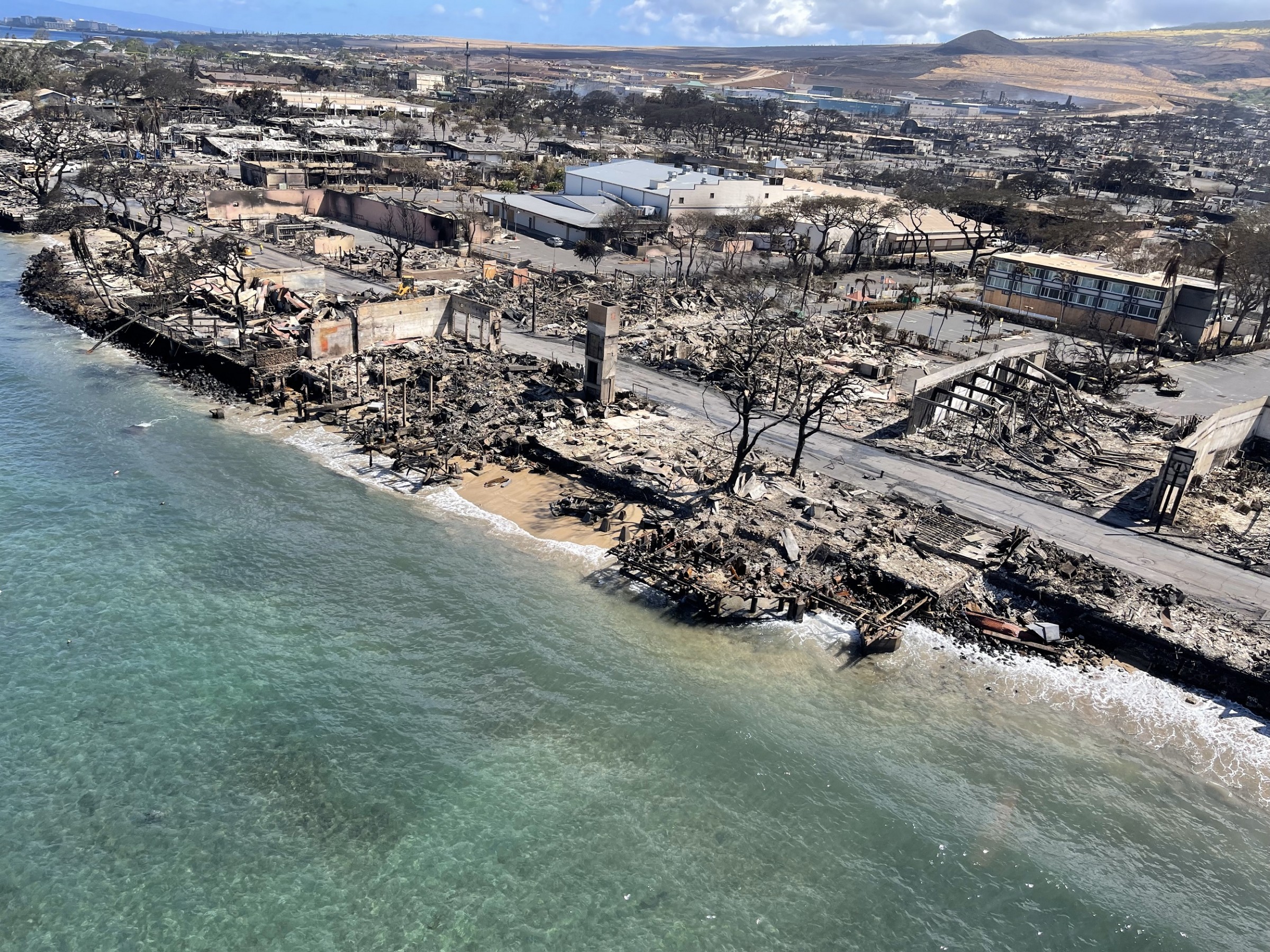The Stream, August 16, 2023: Drought and Overuse Dry Out Historic Agricultural Hub in Armenia

Fires on the island of Maui in early August burned the historic town of Lahaina. Photo courtesy of Hawai‘i DLNR
YOUR GLOBAL RUNDOWN
- To alleviate historic drought and ongoing farmer-herder violence, the Kenyan military has a new directive: plant thousands of seedlings across the country.
- Fish farming, warmer weather, and drought have shrunk western Armenia’s artesian aquifer by more than two-thirds.
- One dozen rainforest countries have signed a pact demanding developed nations aid poorer nations in protecting against climate and biodiversity crises.
- Nine people in northern India have died after a temple collapsed amidst flash floods and landslides — the latest deadly event in what has been an intense monsoon season.
The devastating Maui wildfires, which have killed at least 100 people and destroyed dozens of buildings in Lahaina, were made much more likely due to climate change, scientists say.
“There’s likely a climate change signal in everything we see.” — Abby Frazier, a climatologist at Clark University.
A confluence of weather patterns, brought on by a changing climate affected by global warming, turned “lush Hawaii into a tinderbox,” the New York Times reports.
Nearly 16 percent of Maui County is currently experiencing severe drought, while 20 percent is experiencing moderate drought. Meanwhile, weaker La Niña seasons, which in the 1980s “began delivering less precipitation” than they historically had, have added to the dryness. Scientists also share that higher temperatures, which Maui is experiencing, contribute to thinner cloud cover and, as a result, lower precipitation levels.
Rainforests across the world are experiencing these same changes. “Parts of the Amazon,” per the Times, “are fast approaching this transition, a point of no return when the humid ecosystem would forever change.”
— Christian Thorsberg, Interim Stream Editor
Recent WaterNews from Circle of Blue
- Control for Frog-bit and Water Soldiers — New strategy for limiting the spread of exotic water plants in Michigan.
- Streams of Migration – Special Frontline Report
The Lead
Armenia’s Ararat Valley, the center of the country’s agricultural production, is drying up, Yale E360 reports.
Groundwater levels in the valley’s artesian aquifer have shrunk by two-thirds since the early 1980s, scientists have measured. The decline is due in large part to an expanding fish farming industry. More than 200 aquaculture sites, “with potentially dozens more operating without permits,” are responsible for “more than half of the region’s annual groundwater consumption,” and have “far surpassed the aquifer’s rate of replenishment.” Lenient permitting allowed fish farms to over-extract water from underground reserves and led to the industry’s boom in the valley, Yale reports.
Climate change is also playing a role. Receiving less than a foot of rain per year, the Ararat Valley is “likely to become even drier,” according to Yale, with precipitation declining 8 percent by the turn of the century.
The region’s snowpack has also been melting months earlier. As a result, the basin’s “timeframe for regeneration” has become unpredictable, a further challenge for farmers who rely on the water for irrigation.
Not all fish farmers have eco-friendly harvesting methods. Some do reoxygenate their water and recycle it for future uses. But others have reportedly been draining their tanks into the Aras River, polluting the riparian ecosystem with nitrogen.
This Week’s Top Water Stories, Told In Numbers
14
Percent of Kenya’s tree cover lost between 2002 and 2022 due to large-scale logging — a plight exacerbated recently by 1,000 days of drought in the Horn of Africa. It was the region’s worst in four decades, and ended only this spring. Al Jazeera reports that the drought and loss of primary forest spurred violent conflicts between nomadic pastoralists and farmers competing for what little greenery remained. In 2023, at least 73 people have died. To alleviate the conflict and renew lost forests, the Kenyan military is embarking on a “tree-planting spree…and partnering with grassroots nonprofits to renew forest cover.” So far this year, they have planted 46,000 seedlings.
9
Number of people killed in a Himalayan temple following heavy rains which caused flash floods and landslides in northern India, the New York Times reports. According to officials, at least 25 people are feared to still be trapped under the debris. The event is the latest in what has been a destructive monsoon season in the state of Himachal Pradesh — more than 250 people have died, while dozens more people in Bangladesh and Nepal have lost their lives in recent flooding and landslides.
On the Radar
Last week, 12 rainforest countries — Bolivia, Brazil, Colombia, the Democratic Republic of Congo, Ecuador, Guyana, Indonesia, Peru, the Republic of Congo, Saint Vincent and the Grenadines, Suriname, and Venezuela — signed a joint statement titled “United for Our Forests,” which demands that the world’s richer countries take stronger action in helping poorer countries combat climate change and protect biodiversity, Reuters reports.
Just one day before, the eight countries who comprise the Amazon rainforest agreed to a list of policies meant to protect the world’s largest rainforest, yet failed to reach consensus on deforestation limits by 2030.
The twelve-country pact is a momentum-builder ahead of COP28, the UN climate conference that will take place in late November and early December in Dubai.
More Water News
Juneau: The Mendenhall Glacier’s outburst flood, which sent glacial meltwater into surrounding lakes and rivers and flooded Alaska’s capital, was ‘not possible without climate change,’ according to Climate.gov.
Cultural Resistance: On the Apayao River in the Philippines, where damming threatens to disappear riparian Indigenous homelands, communities are practicing what was once unthinkable — writing down their oral traditions, Sapiens reports.
Christian Thorsberg is an environmental writer from Chicago. He is passionate about climate and cultural phenomena that often appear slow or invisible, and he examines these themes in his journalism, poetry, and fiction.







Leave a Reply
Want to join the discussion?Feel free to contribute!